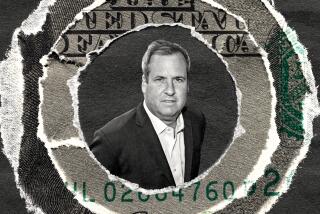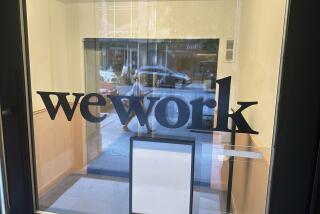Lehman Bros.’ unexpected afterlife
Reporting from New York — Lehman Bros. is supposed to be dead and gone, but if you step off the elevator at the 40th floor of a midtown Manhattan skyscraper, you might think you’ve seen a ghost.
Behind imposing glass doors stands a gleaming brown reception desk displaying, in silver letters, the name of the Wall Street giant that collapsed spectacularly two years ago this month, triggering the worst phase of the financial crisis.
Well-dressed Wall Streeters buzz back and forth. On one floor, investment managers tend to tens of billions of dollars of real estate and other holdings. On another floor, young traders of financial derivatives — the complex securities that took much of the blame for Lehman’s downfall — sit behind computer screens, keeping tabs on thousands of derivatives contracts that Lehman entered into and that remain in force.
All told, the operation has about 500 or so employees, most of whom worked for Lehman before the downfall.
“There are always some strange looks when I say I work here,” said Michael Lascher, who helps manage the real estate assets, just as he did for the pre-Chapter 11 Lehman. “But we’re doing business.”
After Lehman Bros. Holdings Inc. entered bankruptcy proceedings on Sept. 15, 2008, its main operations were sold within days or weeks to rival firms. Most of the remaining assets appeared headed for a quick liquidation. Instead, the team brought in to manage the portfolio for the benefit of Lehman’s creditors plans to emerge from Chapter 11 as a profitable operating company.
But Lehman’s unexpected afterlife pales compared with its life as the country’s fourth-largest investment bank with more than $600 billion in assets, 26,000 employees worldwide and myriad lines of business.
For one thing, it’s still operating under the watchful eye of the U.S. Bankruptcy Court, and is likely to do so for several more years.
The company’s current location — four floors of the Time & Life Building on the edge of Rockefeller Center — used to be a Lehman “back office” performing administrative functions.
From his office, with boxes piled in a corner and nothing on the walls but a white board, Lehman’s current president can see the firm’s old marquee headquarters just down the block on 50th Street. That mammoth structure now displays the name of British-owned Barclays Capital, which snapped up the building along with Lehman’s North American investment bank.
Lehman hadn’t planned much for a bankruptcy, and the first days in Chapter 11 were chaotic. For example, the court filing triggered an avalanche of legal documents from the other parties to Lehman’s derivatives contracts.
The notices were “literally coming in wheelbarrows,” recalled Locke McMurray, a lawyer at Lehman who deals with derivatives. “I had 15 people in a room just opening envelopes.”
Lehman’s current top executives actually work for Alvarez & Marsal, which has been running the company in bankruptcy.
Bryan Marsal, the corporate turnaround firm’s co-chief executive, also serves as CEO of Lehman. About 140 other members of Lehman’s staff, including the president, John Suckow, are Alvarez & Marsal employees.
Soon after the bulk of Lehman’s operations were sold, Marsal and Suckow determined that liquidating the remaining assets — including derivatives, real estate and private equity holdings — during the worst financial crisis since the Great Depression was not the best course of action. To manage the portfolio for the long term, the firm hired back hundreds of Lehman employees who had been shipped off to an uncertain future at Barclays.
The move has paid off so far. As financial markets have rebounded, so has the portfolio, which is now valued at about $50 billion, up from an estimated $33 billion had it been liquidated within a year. As a result, the company projects that creditors will get back more than 14 cents for each dollar of confirmed claims against Lehman.
The effort to maximize the portfolio’s value has led to some unorthodox moves for a bankrupt company. For instance, Lehman has pumped hundreds of millions of dollars into two struggling banks in Utah and Delaware to keep them from failing. The firm also has entered new derivatives contracts to hedge its exposure on other contracts.
Such potentially risky moves were initially opposed by some creditors, but most of them have been won over by the prospect of a bigger recovery.
“They are doing a lot of creative things,” said Charles Tovstein, assistant treasurer of San Mateo County in California, which got stuck holding $150 million in debt issued by Lehman. “The moves they are making seem to be for the better for creditors like us.”
However, Alvarez & Marsal, along with Lehman’s bankruptcy lawyers, has become a focus of controversy because of the fees it has charged to manage the case. Through July fees totaled $917 million, with $326 million of that going to Alvarez & Marsal.
The size of the fees was criticized by Kenneth Feinberg, who was assigned by the bankruptcy judge to monitor them. Feinberg, who until recently was also the “pay czar” under the federal bank bailout program, demanded that the firms doing the work for Lehman cut back on frills.
Suckow, for whose time Lehman pays $750 an hour — Marsal’s hourly rate is $850 — says the fees are small in comparison with what the creditors will get from the firm’s management of the Lehman estate.
“It’s been an expensive case, but we feel very strongly that this has been an efficiently managed case,” Suckow said.
In perhaps its most unusual move, the Lehman team has formed a new asset-management firm staffed with many of the employees now at the company. The plan is for the new firm, named Lamco, to keep managing Lehman’s assets in Chapter 11 and also to seek investment business from pension funds and other institutional investors. The main argument for creating Lamco was that it would allow Lehman to retain good employees by giving them long-term employment prospects. Also, Lehman’s creditors stand to gain if Lamco becomes a profit-making business.
Barry Adler, a bankruptcy expert at New York University’s law school, called the move to form Lamco “creative, innovative and, at least in theory, productive.”
“To take the leftover pieces of a company, the shards of the collapse, and turn that into something new — that seems very novel to me,” Adler said.
Around the office in the Time & Life Building, Lehman’s name is being replaced slowly by Lamco’s. Every employee recently got a green hat with a Lamco logo.
More to Read
Inside the business of entertainment
The Wide Shot brings you news, analysis and insights on everything from streaming wars to production — and what it all means for the future.
You may occasionally receive promotional content from the Los Angeles Times.










